Related Research Articles
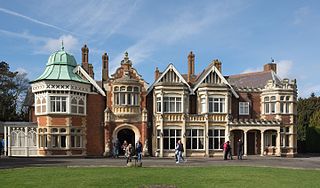
Bletchley Park is an English country house and estate in Bletchley, Milton Keynes (Buckinghamshire), that became the principal centre of Allied code-breaking during the Second World War. The mansion was constructed during the years following 1883 for the financier and politician Herbert Leon in the Victorian Gothic, Tudor and Dutch Baroque styles, on the site of older buildings of the same name.

Communications security is the discipline of preventing unauthorized interceptors from accessing telecommunications in an intelligible form, while still delivering content to the intended recipients.
MI8, or Military Intelligence, Section 8 was a British Military Intelligence group responsible for signals intelligence and was created in 1914. It originally consisted of four sections: MI8(a), which dealt with wireless policy; MI8(b), based at the General Post Office, dealt with commercial and trade cables; MI8(c) dealt with the distribution of intelligence derived from censorship; and MI8(d), which liaised with the cable companies. During World War I MI8 officers were posted to the cable terminals at Poldhu Point and Mullion in Cornwall and Clifden in County Galway, continued until 1917 when the work was taken over by the Admiralty. In WW2, MI8 was responsible for the extensive War Office Y Group and briefly, for the Radio Security Service.

Camp X was the unofficial name of the secret Special Training School No. 103, a Second World War British paramilitary installation for training covert agents in the methods required for success in clandestine operations. It was located on the northwestern shore of Lake Ontario between Whitby and Oshawa in Ontario, Canada. The area is known today as Intrepid Park, after the code name for Sir William Stephenson, Director of British Security Co-ordination (BSC), who established the program to create the training facility.
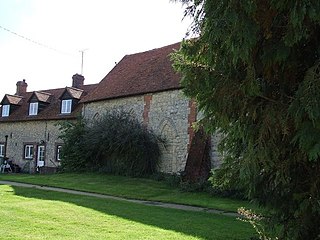
Creslow is a village and civil parish within Aylesbury Vale district in Buckinghamshire, England. It is close to Whitchurch, about six and a half miles from Aylesbury. It is in the civil parish of Witchurch.

Gawcott is a village about 1.5 miles (2.4 km) southwest of Buckingham in the Buckinghamshire district in the ceremonial county of Buckinghamshire, England. The village is in the civil parish of Gawcott with Lenborough.

Poundon is a hamlet and a civil parish in Aylesbury Vale district in Buckinghamshire, England. It is located near the Oxfordshire border, about four miles northeast of Bicester, three miles southwest of Steeple Claydon.

Whaddon is a village and also a civil parish in Buckinghamshire, England, within the Buckinghamshire Council unitary authority area. It is situated just outside of Bletchley, a constituent town of Milton Keynes.
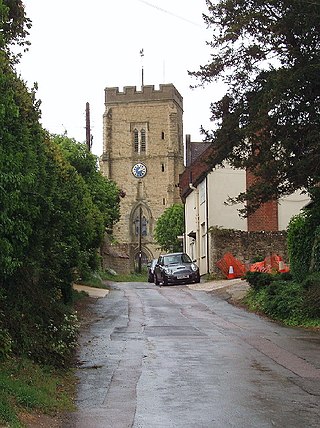
Whitchurch is a village and civil parish in the unitary authority area of Buckinghamshire, England. The village is on the A413 road about 4 miles (6.4 km) north of Aylesbury and 4.5 miles (7 km) south of Winslow. The 2011 Census recorded a parish population of 932.
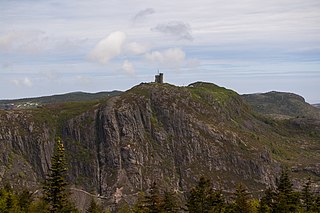
Signal Hill is a hill which overlooks the harbour and city of St. John's, Newfoundland and Labrador, Canada. The majority of Signal Hill, including Cabot Tower, is designated a National Historic Site. The highest point, Ladies' Lookout, is 167 m (548 ft) high.

HMAS Harman is a Royal Australian Navy (RAN) base that serves as a communications and logistics facility. The main base is located in the Australian capital of Canberra, and is geographically recognised as the suburb of Harman in the District of Jerrabomberra. Established in the late 1930s as the Royal Australian Navy Wireless/Transmitting Station Canberra, the facility was commissioned into the RAN as a stone frigate in 1943. In addition to its communications and logistics roles, the base hosts reserve units from both the Australian Army Reserves and Royal Australian Air Force Reserves, as well as cadet units from all three branches of the Australian Defence Force Cadets.
His Majesty's Government Communications Centre (HMGCC) is an organisation which provides electronics and software to support the communication needs of the Government of the United Kingdom. Based at Hanslope Park, near Milton Keynes in Buckinghamshire, it is closely linked with the Foreign, Commonwealth and Development Office and the British intelligence agencies.
Admiralty House is a one-storey, wooden gable-roofed, municipally-designated heritage building originally built as a wireless communications station in Mount Pearl, Newfoundland and Labrador, Canada. It currently serves as a museum and archives. The building is purported to be the last standing of 11 such identical stations built around the world during the First World War.
The "Y" service was a network of British signals intelligence collection sites, the Y-stations. The service was established during the First World War and used again during the Second World War. The sites were operated by a range of agencies including the Army, Navy and RAF, and the Foreign Office. The General Post Office and the Marconi Company provided some receiving stations, ashore and afloat. There were more than 600 receiving sets in use at Y-stations during the Second World War.

Aspidistra was a British medium-wave radio transmitter used for black propaganda and military deception purposes against Nazi Germany during World War II. At times in its history it was the most powerful broadcast transmitter in the world. Its name – after the popular foliage houseplant – was inspired by the 1938 comic song "The Biggest Aspidistra in the World", best known as sung by Gracie Fields.

BT Research is the research arm of BT Group, formerly part of the British Post Office. The company was first established in 1921 as the Post Office Research Station at Dollis Hill, London. In 1968 BT moved of its research to the new site at Martlesham Heath based on part of the old Royal Air Force Station at Martlesham Heath near Ipswich in the English county of Suffolk, which was later renamed Adastral Park.
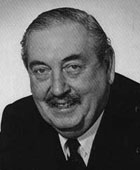
Brigadier Sir Richard Gambier-Parry, was a British military officer who served in both the army and the air force during World War I. He remained in military service post-war, but then entered into civilian life for more than a decade. In 1938, he was recruited by the head of the Secret Intelligence Service. Gambier-Parry led the Communications Section of the SIS during World War II, and assembled a clandestine wireless network that connected the United Kingdom with SIS agents in many countries, as well as helping to create the SIS resistance network in Britain. During the war, he was also recruited by the Director of British Naval Intelligence to serve as the radio consultant for Operation Tracer in Gibraltar. Post-war, he ran a network of secret listening stations.

Whaddon Hall is a country house in Whaddon, Buckinghamshire. It is a Grade II listed building.
References
- ↑ "Foreign Office Properties" . Retrieved 2019-11-21.
- ↑ Pidgeon, Geoffrey (2003). The Secret Wireless War - The story of MI6 communications, 1939-1945. St Leonards-on-Sea: UPSO. p. 381. ISBN 1-84375-252-2.
- ↑ "Electronic Communities Ltd".
- ↑ "IBM 360 Restoration Blog" . Retrieved 2020-06-01.